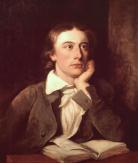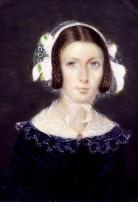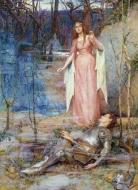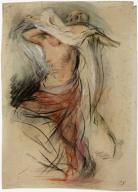La Belle Dame sans Merci: A Ballad-Hannah McInvale
Created by Hannah McInvale on Fri, 10/22/2021 - 13:32
Part of Group:
I am interested in showing how John Keats reflects his struggles with disease and death during his lifetime in his poem "La Belle Dame sans Merci: A Ballad". A ballad is defined in the dictionary as a poem or song that narrates the author's story they wish to tell. "La Belle Dame sans Merci" truly is a ballad as we can see John Keat's life reflects upon his work in a Pre-Raphealite manner, as one who struggles to escape darkness.
Timeline
Chronological table
| Date | Event | Created by | Associated Places | |
|---|---|---|---|---|
| circa. 1822 to circa. 1822 |
Portrait of John Keats by William HiltonThis is a painting of John Keats. This portrait was painted by WIlliam Hilton Circa 1822. This painting is an oil on canvas. This work allows us to see what John Keats appearance could have looked like shortly before his death. This painting was painted in 1822, only a year after Keats died. He appears to have a pale, thin face. This does support the idea that Keats was very sickly while he was writting "La Belle Dame sans Merci: A Ballad". This work was written just a few years prior to this painting in 1819. He was struggling with a disease called tuberculosis and he envisioned his death coming soon due to this. Keats was trying to find an escape from the "darkness" that he considered his disease. His outlook on life was grim. This aligns with the the beliefs of the Pre-Raphealites, who were searching an escape from "darkness" in works of literature, artwork, and life. In this painting, Keats' face seems to appear as if he was pondering on some idea. I belive this adds to our understanding of who Keats was as a person. Keats was someone who was pondering upon misery and death due to his circumstances in life. |
Hannah McInvale | ||
| circa. 1833 to circa. 1833 |
Portrait of Fanny BrawneThis portrait is a miniature of Fanny Brawn. This miniature was painted in watercolours. Portraits such as this are important so that we can begin to picture the person of whom the portrait is painted. Fanny Brawne was the focus of John Keat's attention throughout his adult life. He had such passion for her, even in his hard times when he was struggling with disease. Miss Brawne was often the center of Keats' literary works. She was a light for him as he struggled through his "darkness" that eventually led to death. Miss Brawne being a light to Keats is reflected in "La Belle Dame sans Merci". Fanny Brawne is a source of hope for John Keats as he combats his disease, but he can never attain what he desires- a true relationship with Miss Brawne. This is comparable to the Knight within the poem, wishing for the Faery to be his...But just as Keats could never have Fanny, the Faery disappeared from the Knight's company. |
Hannah McInvale | ||
| circa. 1901 to circa. Autumn 1901 |
La Belle Dame sans Merci PaintingThis painting is title "La Belle Dame sans Merci" after John Keats poem. The painter was Henry Meynell Rheam. He painted in watercolour on paper. This painting helps us to better visualize John Keat's work. The painting is of a womenly figure standing over a knight who seems to be in a daze. This does represent the faery, in the way the painter interprets John Keats description of the faery and the knight. The faery appears to be a soft feminine figure who stands out with bright, soft colors which contrast to the dark colors of her surroundings and the knight. The knight is painted as being in a daze under this feminine figure, yet she holds his attention. He is searching and trying to cling to the light as he grows sickly. |
Hannah McInvale | ||
| circa. 1901 to circa. Winter 1901 |
La Belle Dame sans Merci Painting 2La Belle Dame sans Merci is once again a title of a poem that is based upon John Keats poem. This work is a painting by Dicksee Frank. The medium is an oil on canvas. This painting was painted in a Pre-Raphaelite style. The colors are vivid and smooth. This painting is helpful in showing how the painter interprets a part of John Keat's poem. The visual representation helps us to better understand the poem and one way of interpreting the poem. This Pre-Raphaelite painting is airy and soft. The knight has placed the faery on his steed, giving her a place of authority and importance in his life. As the Faery sits on the Knight's horse, she seems to be drawing him in for a kiss. She has power over the Knight and has him in a trance where she will lead him for her cave. |
Hannah McInvale | ||
| circa. 1936 to circa. 1936 |
The Focus of DeathThis work is titled "Death" by Clara Siewart. This is a work is charcoal on paper. This work does envision the idea of the Lady of death or the personification of a female death. Death is a common presence in John Keats' poem "La Belle Dame sans Merci". This work show an example of a female figure of death that John Keats could have been imagining while he was writing on his poem. This deathly figure has a feminine figure. The skull personifies death upon the feminine figure, almost as if she is supporting death up or guiding death along. |
Hannah McInvale |





